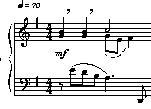OK. I’m officially excited. They’ve offered me the position; we’re ironing out some details. And I may have Jeremy and Amanda’s piece done, at least to the point where I play it on piano, seeing if I can break it and then fix it (kind of a Quality Control approach). If you read on you’ll notice that the excerpt I showed in my last post isn’t part of this piece…because I started over. I often do that–a couple of false starts plus a job offer gets my creative energy flowing…[I won’t drop my previous idea: it will have hints of Jesu, Joy–see below–and will probably lead to my writing a third or fourth piece so I can postnuptually offer Suite Joy to A & J]
So I noticed that the happy couple had picked Jesu, Joy of Man’s Desiring and Ode to Joy for walking in and walking out music. Even though I was writing an interlude sort of piece I wanted it to have some sort of liturgical connection by relating my piece to one of their choices. I developed three ideas–short motifs–and knitted them into the musical fabric (slightly too subtle reference to Marianne’s knitting her “Mother of the Groom” dress). The first motive is based on the first three notes of Ode to Joy. There may be a reference to the running eighth notes of Jesu in the accompanying material, but that was unintentional. This motive is immediately varied
Even though I was writing an interlude sort of piece I wanted it to have some sort of liturgical connection by relating my piece to one of their choices. I developed three ideas–short motifs–and knitted them into the musical fabric (slightly too subtle reference to Marianne’s knitting her “Mother of the Groom” dress). The first motive is based on the first three notes of Ode to Joy. There may be a reference to the running eighth notes of Jesu in the accompanying material, but that was unintentional. This motive is immediately varied (up an octave, expanded, softer), setting the context for similar developments of the other motivic material that followed. A second, contrasting idea functions more as punctuation.
(up an octave, expanded, softer), setting the context for similar developments of the other motivic material that followed. A second, contrasting idea functions more as punctuation.
I wanted the piece to be improvisatory in feeling; people like music with a Romantic or Impressionist flavor; a nice arpeggio seemed to fill the bill. Did I mention the title? Reflected Joy seemed appropriate on a number of levels: the word “joy” in the music they chose; my piece being a reflection or meditation on their choices; the joy that we feel at their joy in each other.
As I returned to the hymn tune I decided I didn’t want to just go back to my first idea; the thought of Impressionism made me think more chromatically and led to the development of the third motive, which gets a (to me) surprisingly large amount of play in the piece. It’s developed the most, it leads to a couple climax points, and allows for some quite satisfactory expressive playing.
first idea; the thought of Impressionism made me think more chromatically and led to the development of the third motive, which gets a (to me) surprisingly large amount of play in the piece. It’s developed the most, it leads to a couple climax points, and allows for some quite satisfactory expressive playing.
Did I mention how much fun I was having writing this piece? It occured to me at some point–about a minute into this two-minute piece–that I hadn’t actually stated more than three or four notes of the theme (Ode to Joy) so I decided to refer more clearly to it, even though I was putting it in musical parentheses. It’s softer than surrounding material, presented over a relatively static pattern, so that it’s actually a break in the action, and not the main idea.
It occured to me at some point–about a minute into this two-minute piece–that I hadn’t actually stated more than three or four notes of the theme (Ode to Joy) so I decided to refer more clearly to it, even though I was putting it in musical parentheses. It’s softer than surrounding material, presented over a relatively static pattern, so that it’s actually a break in the action, and not the main idea.
At some point all this joy has to end. Translation: I was getting tired and was ready to call it a night and get some sleep. In addition, the piece had reached the 2-minute mark; it was in danger of becoming a musical elephant in the liturgical china shop, so it was time to end, which I did with a final reference to the end of Ode to Joy as it’s usually done in hymnals…with a slight contemporary flavor. (Note that the lower stave is initially in treble clef). I’ve made a MIDI file of the score which will give you an idea of the piece until I get around to making a recording.

2 Responses to Turning part 2: Reflected Joy